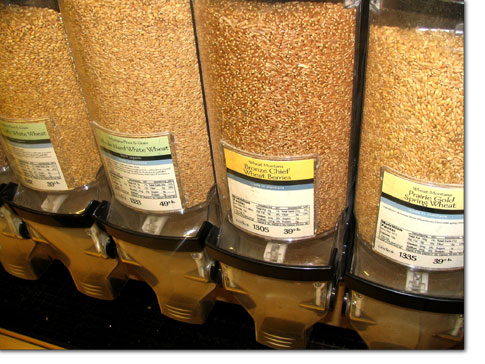| ||
The cuisine of home
by Chef Boy Ari When you think of flour, is there a particular grain that comes to mind? If you’re one of them hippies or health-foodies, maybe you think quinoa flour or millet flour. But while any grain can be ground, most English speakers, faced with the word “flour,” think of wheat and the many things made with wheat flour, like cake, bread, pasta, pancakes, cookies and pizza crust. In Asia, home to half the world’s population, rice is the staple grain. When you think of rice, what do you think of? I think of whole grains of rice in a bowl beneath some kind of fabulous meat and/or vegetable sauce, like teriyaki stir-fry or curry, held at mouth level and shoveled home with chopsticks. While rice noodles, rice milk and other manifestations of rice do exist, most rice presentations — including non-chopstick varieties such as rice and beans, rice pilaf and rice-stuffed grape leaves — involve whole rice grains. A pet project of mine is to take my love of food, which knows no borders, and focus it on the ingredients at hand here at home. In my case, home happens to be in Montana, where the plains meet the mountains. But I believe that practically any region in the world, if given the time and effort, could produce a cuisine to rival that of Tuscany, Provence, Japan or Thailand. Indeed, I love a good homegrown meal, with homegrown veggies, local meat and a loaf of bread made from regionally grown wheat. While it may not be as refined as sushi, this meal can hit the spot with the best of them. But alas, I’ll always have a soft spot for that bowl of rice covered with sauce. In summer, I play around with stir-fries made from local produce, with local animal protein seasoned and cooked in oil to perfection ahead of time and set aside to be mixed back in when the stir-fry is complete. The mixture is then served atop California rice, and I call it locally produced Asian-style food, with only the soy sauce imported. And of course the rice. Winter can present a challenge to eating locally. While grains store well and are available year round, the only veggie options are what you squirreled away from last summer, and whatever local stuff your grocery store can supply. As I walked around the store the other day, it seemed like the whole damn meal was going to be from California. Nothing against that lovely state, but we have what it takes right here at home to eat all year long. I thought about my stash, which includes dried and frozen greens, frozen deer, dried zucchini slices, dried peppers, and carrots, onions and garlic. With a stash like this, I concluded, I could eat like a local emperor! But not a local Asian emperor, of course, because he would eat his winter stir-fry over rice. I wandered over to the store’s bulk section and coveted the rice, in all its forms and flavors. Short grain, long grain, basmati, jasmine, white and brown … and exotics, like black-grained Chinese Forbidden Rice (supposedly developed and cultivated exclusively for the emperor) and Bhutanese red rice. On the other side of the bulk bins were the wheat berries, in a similar spectrum of whole-grain options: hard red winter, hard red spring, soft red winter, soft white, hard white, durum, kamut… . Hard wheat has more protein and gluten, soft has more starch. Winter wheat is sown in fall in southern regions, spring wheat is sown in spring and grows all summer. Usually folks buy the whole wheat grains and grind them, either at home or at the store’s wheat grinder. Some people take home the wheat berries, sprout them and make sprouted wheat bread. But for some strange reason, few people take wheat berries home, cook them whole and serve them with stir-fry. But that’s what I did with kernels of soft red winter wheat.Soaking wheat berries overnight cuts the cooking time in half, down from about 45 minutes on medium heat in a 1:3 proportion with lightly salted water. If that doesn’t make them soft enough, add more water and cook a bit longer. If the berries reach your desired softness earlier, stop cooking and drain the water. Served with a stir-fry of zucchini, greens, carrots, onions and garlic with crispy-fried deer chunks in oyster sauce, the wheat berries acted like rice, adding body to the mouthfuls while contributing their distinct yet subtle flavor to the fabulous mix. Only the oyster sauce was imported. For days, the experiments continued. Next was a wheat berry risotto that combined hard winter red and soft white wheat berries, and, for poetic resolution, Midwestern wild rice. I cooked the two wheats and the rice in separate pots of salted water until they were done, then drained, mixed and cooked them, risotto-style, with wild mushrooms, sherry, butter, shallots and chicken stock, and served them with venison in a green peppercorn Madeira demi-glace. It was a darn good meal, a small step forward for me and home cookin.’ •
|


